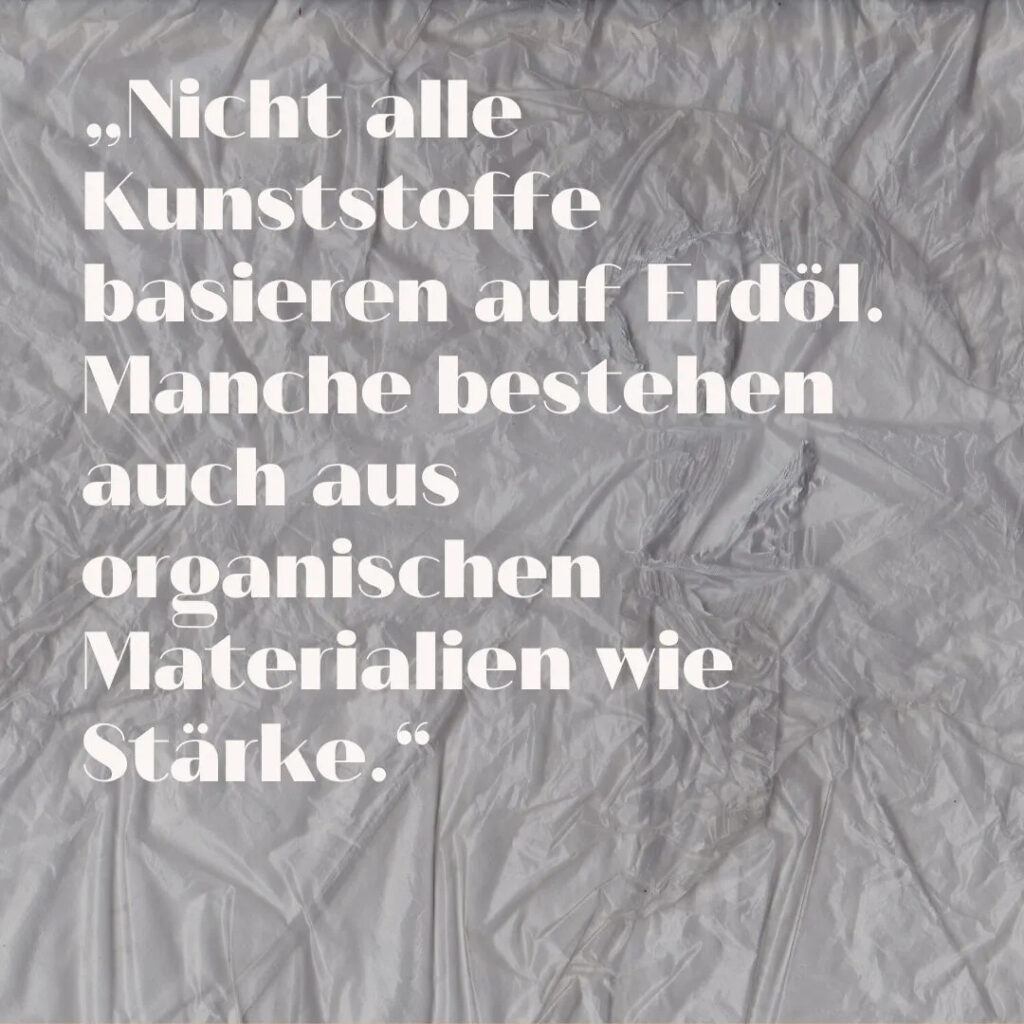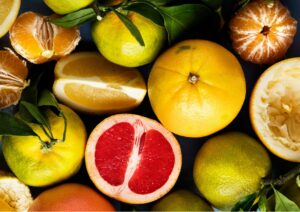Startseite » BIOvative Magazin » Biologisch abbaubar, kompostierbar, biobasiert, recyclebar – Bedeutung und Unterschied
Beitrags-Inhaltsverzeichnis
- Kunststoffe - der Unterschied liegt im Detail
- Von biologisch abbaubar bis Recycling - die Unterschiede auf einen Blick
- Biologisch abbaubar - Zersetzung ohne Zeitdruck
- Kompostierbar - Zersetzung mit Ansage
- Biobasierte Kunststoffe - aus nachwachsenden Rohstoffen
- Recyclebare Kunststoffe - Verwertung als Mogelpackung
- Mit BIOvative in eine nachhaltige Zukunft

Biologisch abbaubar, kompostierbar, biobasiert, recyclebar – Bedeutung und Unterschied
- 11. Januar 2023
- Autor: Uwe Friebel
- Lesezeit: 9 Minuten
In der Welt der Nachhaltigkeit wirst Du an jeder Ecke mit Begriffen wie “biologisch abbaubar“, „kompostierbar“, „biobasiert“ oder “recyclebar“ konfrontiert. Doch was bedeuten diese Begriffe eigentlich? Oft klingt es, als seien die verschiedenen Bezeichnungen synonym verwendbar. Tatsächlich gibt es aber detaillierte Unterschiede zwischen den einzelnen Begriffen. Schauen wir uns an, wo die Unterschiede liegen!
Kunststoffe - der Unterschied liegt im Detail
Bevor wir klären, wie sich die einzelnen Stoffe im Detail unterscheiden, müssen wir klären, worüber wir reden. Egal ob biologisch abbaubar, kompostierbar, biobasiert oder recyclebar: All diese Begriffe beziehen sich auf Kunststoffe. Viele Gegenstände unseres Alltags werden aus Kunststoffen gefertigt. Dazu gehören beispielsweise Müllbeutel, Folien, Geschirr, aber auch Kleidung und sogar Möbel werden aus Kunststoff hergestellt.
Das Deutsche Kunststoffmuseum definiert Kunststoff sinngemäß folgendermaßen:
Kunststoffe sind Stoffe, die von Fachleuten für einen speziellen Einsatzzweck eigens angefertigt werden. Sie bestehen aus künstlichen Polymeren, die sich mit Hilfe von chemischen Reaktionen zu unterschiedlichsten Stoffen in verschiedenen Formen zusammenfügen lassen.
Polymere sind lange Ketten aus Atomen und Molekülen, die in Fäden zusammenhängen. Der Clou dabei: Nicht alle Kunststoffe basieren auf Erdöl. Manche bestehen auch aus organischen Materialien wie Stärke. Dabei unterscheidet sich die genaue, chemische Zusammensetzung der einzelnen Kunststoffe teils erheblich. Genau deshalb lassen sich Kunststoffe in “biologisch abbaubar” und “biologisch nicht abbaubar” unterscheiden.

Von biologisch abbaubar bis Recycling - die Unterschiede auf einen Blick
Biologisch abbaubar:
- Der Stoff wird in einem nicht steuerbaren, biologischen Prozess zersetzt.
- Heißt nicht, dass der Stoff auch kompostierbar ist.
- Der Begriff darf auch für Kunststoffe auf Erdölbasis genutzt werden, dabei entsteht allerdings das umstrittene Mikroplastik.
Kompostierbar:
- Der Kunststoff wird über einen menschlich steuerbaren Prozess biologisch abgebaut (bspw. in industriellen Kompostierungsanlagen).
- Alle kompostierbaren Kunststoffe sind auch biologisch abbaubar.
Biobasiert:
- Nicht alle biobasierten Kunststoffe sind auch biologisch abbaubar.
- Kunststoff darf schon als biobasiert gelabelt werden, wenn nur 40 Prozent nachwachsende Rohstoffe enthalten sind.
Recyclebar
- Kein biologischer Abbauprozess, sondern industrielle Wiederverwertung
- Die meisten Verpackungen, die über den Gelben Sack entsorgt werden, können nicht wiederverwertet werden.
- Kunststoffe, die nicht wiederverwertet werden können, werden verbrannt.
Was die Begriffe im Detail bedeuten erklären wir Dir jetzt:
Biologisch abbaubar - Zersetzung ohne Zeitdruck
Zu den biologisch abbaubaren Kunststoffen gehören zum Beispiel:
- Thermoplastische Stärke
- Cellulose
- Abbaubare Polyester
- Polylactid
Was genau man unter biologisch abbaubaren Kunststoffen versteht, definiert dabei das Deutsche Institut für Normierung (DIN). Die Definition lautet sinngemäß:
Biologisch abbaubare Kunststoffe sind Kunststoffe, die durch biologische Prozesse verwertet werden. Das bedeutet, Mikroorganismen wie Bakterien oder Pilze können diese Stoffe sowohl an der Luft als auch ohne die Hinzunahme von Sauerstoff in Abfallprodukte wie Kohlendioxid (CO2), Wasser, Salze und Biomasse zersetzen.
Der Teufel liegt hierbei im Detail: Die Kennzeichnung als “biologisch abbaubar” sagt nichts über die Zeitspanne aus, die benötigt wird, bis der Stoff vollständig zersetzt ist. Das bedeutet, auch wenn die Mikroorganismen Jahre oder Jahrzehnte brauchen, um den Stoff zu verwerten, gilt der Kunststoff als biologisch abbaubar.
So funktioniert der biologische Abbau
- Zuerst verändern Bakterien die Struktur des Ausgangsstoffes, sodass dieser für andere Mikroorganismen verwertbar wird.
- Beim Abbau des Stoffes entstehen die sogenannten Metabolite. Diese Substanzen werden in feineren Schritten zu immer kleineren Abfallprodukten zerlegt.
- Im letzten Schritt, bei der Mineralisierung, entstehen schließlich Wasser, Kohlendioxid (CO2), mineralische Salze und Biomasse.
Ob ein Kunststoff biologisch abbaubar ist, hängt nicht zwingend vom Material ab, sondern von der chemischen Struktur des Stoffes. Das bedeutet, auch Kunststoffe, die auf Erdölbasis hergestellt werden, können unter Umständen biologisch abbaubar sein. Diese Stoffe bezeichnet man als oxo-abbaubare Kunststoffe.
Der Haken an oxo-abbaubaren Kunststoffen
Oxo-abbaubare Kunststoffe basieren auf fossilen Energieträgern und Stoffen, die bei Lichteinfluss ihre chemische Struktur verändern, sodass sich das Material zersetzt. Allerdings entsteht dabei Mikroplastik, das in die Umwelt gelangt und mittlerweile sogar in Blut und Muttermilch von Menschen nachgewiesen werden konnte. Da Mikroplastik aufgrund der Wirkung auf Mensch und Tier stark umstritten ist, spricht sich sogar das EU-Parlament für ein Verbot der oxo-abbaubaren Kunststoffe aus.
Weil biologisch abbaubare Kunststoffe nicht für die Kompostierungsanlage geeignet sind, landen entsprechende Verpackungen oft in der Gelben Tonne oder dem Gelben Sack. Aufgrund bestimmter Zusatzstoffe können sie aber die Wertstoffmasse im Recycling unbrauchbar machen. Damit eignet sich die Masse schließlich nur für die Verbrennung.
Kompostierbar - Zersetzung mit Ansage
Ist ein Kunststoff kompostierbar, bedeutet das, dass der Stoff in einem festen Zeitraum und unter bestimmten Bedingungen biologisch abgebaut werden kann. Anders als bei biologisch abbaubaren Stoffen handelt es sich bei der Kompostierung von Kunststoff, um einen menschlich gesteuerten Prozess.
Dabei dürfen Zusatzstoffe in kompostierbaren Kunststoffen maximal 1% der Ausgangsmasse ausmachen. Außerdem müssen die Kunststoffe ungiftig sein und dürfen keine negative Auswirkung auf das Pflanzenwachstum haben. Der kleine, aber feine Unterschied: Jeder kompostierbare Kunststoff ist biologisch abbaubar. Aber nicht jeder biologisch abbaubare Kunststoff ist kompostierbar.

Das Deutsche Institut für Normierung vergibt zwei verschiedene Zertifikate für die Kompostierbarkeit:
- Kompostierbar in industrieller Kompostieranlage: Nach DIN EN 13432 muss der Kunststoff in einer industriellen Kompostieranlage bei 60°C innerhalb von drei Monaten zersetzt werden. Dabei dürfen maximal 10 Prozent der Biomasse zurückbleiben, wenn die Reste durch ein Sieb mit 2-Millimeter-Öffnung gepresst werden. Stoffe, die diese Voraussetzungen erfüllen, können mit den Zertifikaten “Keimling” oder “OK Compost INDUSTRIAL” ausgezeichnet werden.
- Kompostierbar auf dem Gartenkompost: Kunststoffe mit diesem Zertifikat oder dem Zertifikat “OK Compost HOME” dürfen in den Gartenkompost. Dort müssen sie sich bei einer Umgebungstemperatur im Kompost von 30°C innerhalb eines Jahres zersetzen.
Sind Kunststoffe mit dem Zertifikat “Kompostierbar” versehen, heißt das allerdings nicht, dass Du sie einfach in der freien Natur zurücklassen darfst.Denn damit die Kompostierung einsetzt, müssen bestimmte Rahmenbedingungen gegeben sein, die Du auf einer Wiese oder im Wald so nicht vorfindest.
Biobasierte Kunststoffe - aus nachwachsenden Rohstoffen
Als biobasiert werden Kunststoffe bezeichnet, die teilweise aus nachhaltigen Rohstoffen bestehen. Das bedeutet, die Rohstoffe wachsen ganz oder teilweise nach. Dazu gehören Holz, Maisstärke oder Ölsaaten. Die Definition findest Du in der DIN 16575 des Deutschen Instituts für Normierung.
Oben hast Du gelernt, dass es auf die chemische Struktur eines Stoffes ankommt, ob er biologisch abbaubar ist. Das bedeutet leider auch:
Nicht alle biobasierten Kunststoffe sind auch biologisch abbaubar.
Das liegt unter anderem auch daran, dass ein Kunststoff schon als biobasiert gelabelt werden darf, wenn nur 40 Prozent nachwachsende Rohstoffe enthalten sind.
- Möbel, die aus Holzsplittern und Verbundstoffen bestehen, sind biobasiert, aber nicht biologisch abbaubar.
- Einweggeschirr aus Maisstärke ist biobasiert UND biologisch abbaubar.
Recyclebare Kunststoffe - Verwertung als Mogelpackung
Der Recyclingprozess sieht die Wiederaufbereitung von weggeworfenen Werkstoffen zu einem neuen Produkt vor. Dem voraus geht das Schreddern oder Einschmelzen des Ausgangsprodukts, sodass der gewonnene Wertstoff übrig bleibt. Allerdings hat die Sache einen Haken.
Die meisten Verpackungen, die über den Gelben Sack entsorgt werden, können häufig nicht in Form neuer Produkte wiederverwertet werden. Oft sind die Verpackungen so verunreinigt, dass sie nicht geschreddert und entsprechend eingeschmolzen werden können.
Kunststoffe, die in der Recyclinganlage nicht eindeutig heraus sortiert und gereinigt werden können, gehen in die sogenannte energetische Verwertung. Das heißt, der Müll wird verbrannt. Für die Müllverbrennung ist in Deutschland allerdings festgelegt, dass die dabei entstehende Energie industriell genutzt werden muss. Das geschieht beispielsweise in Form von Stromerzeugung.
Der Begriff recyclebar ist nicht geschützt und damit auch nicht normiert. Für Dich heißt das in der Praxis:
Du weißt vorher nicht, ob die Verpackung wirklich wiederverwertet oder am Ende doch nur verbrannt wird.
Mit BIOvative in eine nachhaltige Zukunft
Unser großes Sortiment an Müllbeuteln aus Biofolie ist innerhalb von 6 Wochen in einer industriellen Kompostieranlage vollständig kompostierbar und biologisch abbaubar. So helfen Dir unsere Müllbeutel dabei, im Alltag der Umwelt etwas Gutes zu tun.

Uwe Friebel

Uwe Friebel
Diese Artikel könnten dich auch interessieren

Zeitungspapier
Grundsätzlich ist Zeitungspapier biologisch abbaubar und kann daher auch in geringen Mengen in die Biotonne geworfen werden.

Zitrusfrüchte
Besonders in den Wintermonaten, wenn Orangen Hochsaison haben, stapeln sich die aromatischen Schalen von Zitrusfrüchten in den Küchen. Doch wohin damit? Die erfreuliche Antwort: Orangen, Zitronen, Limetten und andere Zitrusfrüchte gehören definitiv in den Biomüll. Sie sind ein wertvoller, wenn auch etwas spezieller Beitrag zum Kompost.

Brot
Brot besteht hauptsächlich aus Mehl und ist somit ein natürliches, organisches Lebensmittel. Als solches ist es biologisch abbaubar und du kannst es problemlos in der Biotonne entsorgen. Dabei spielt es keine Rolle ob es sich um frisches Brot, Reste oder sogar verschimmeltes Brot handelt.

